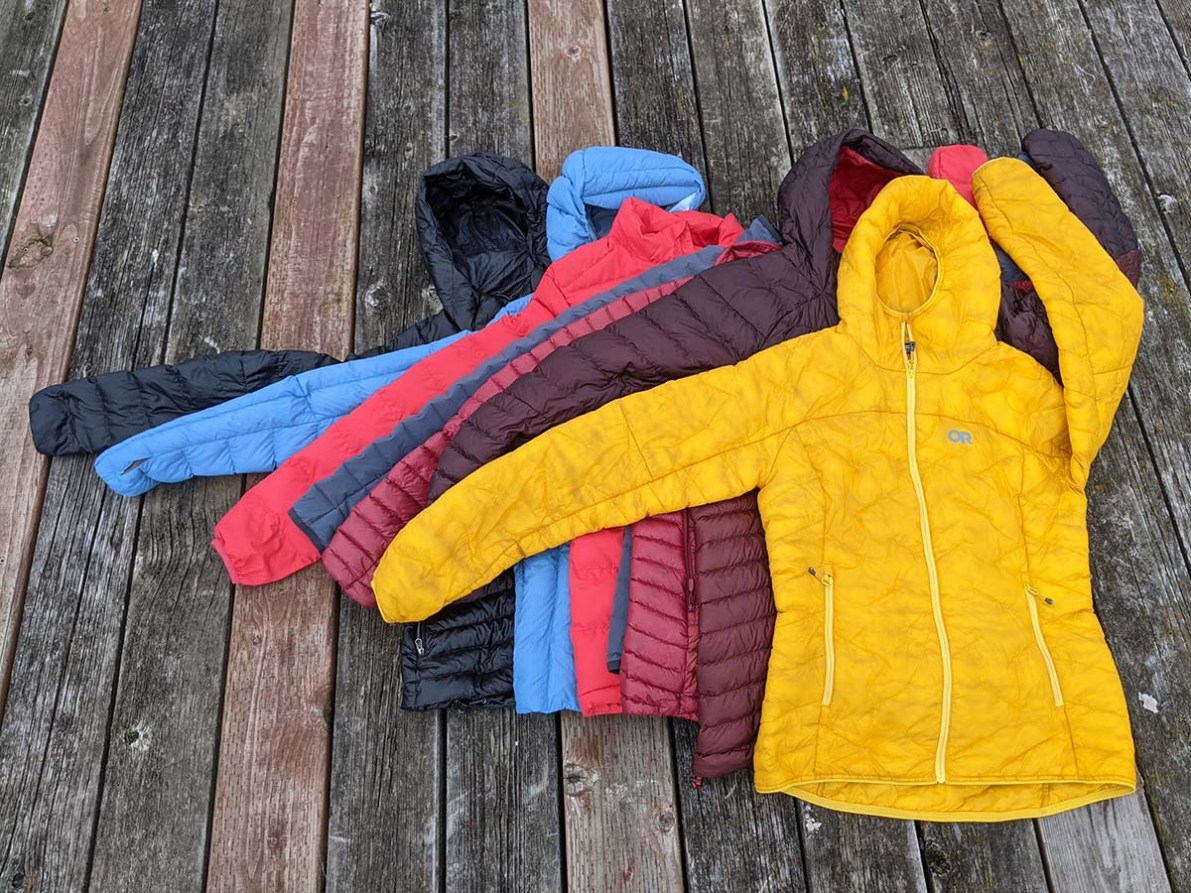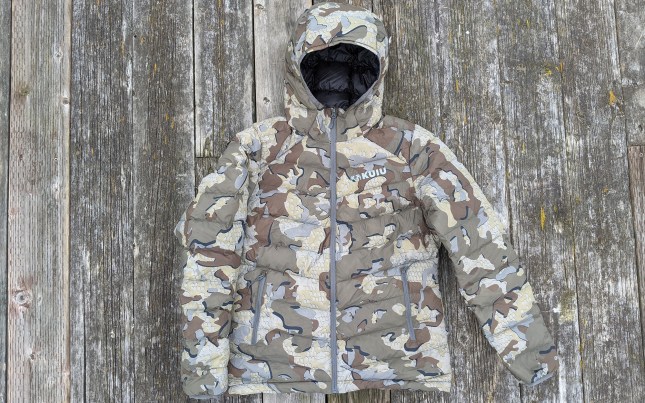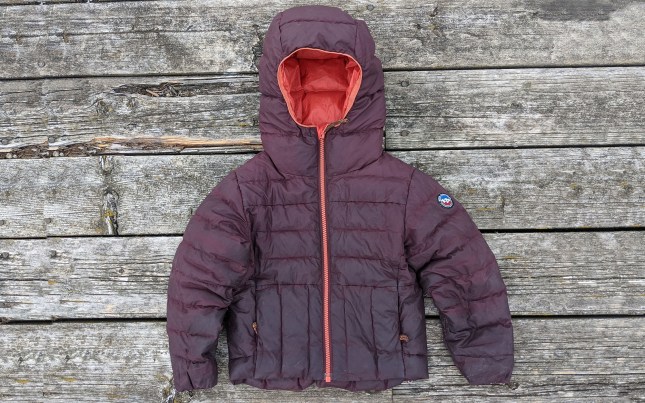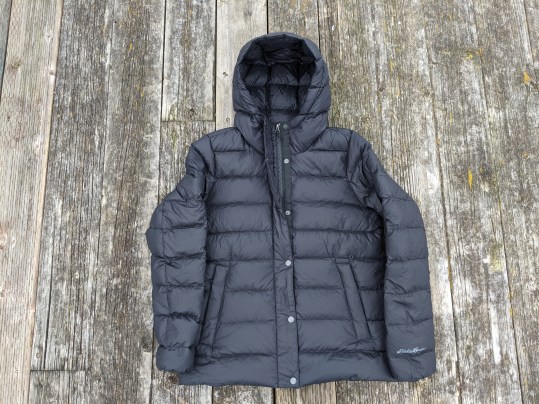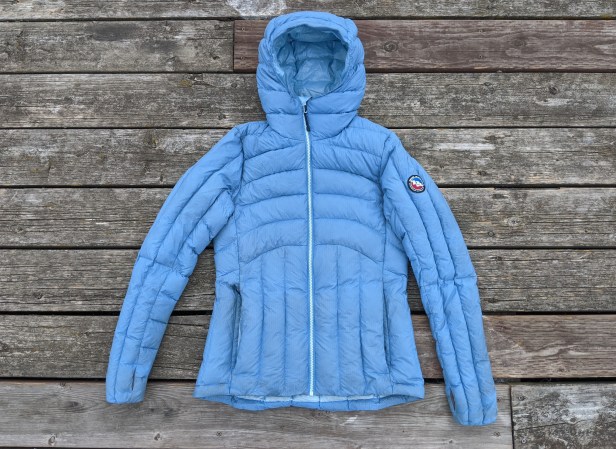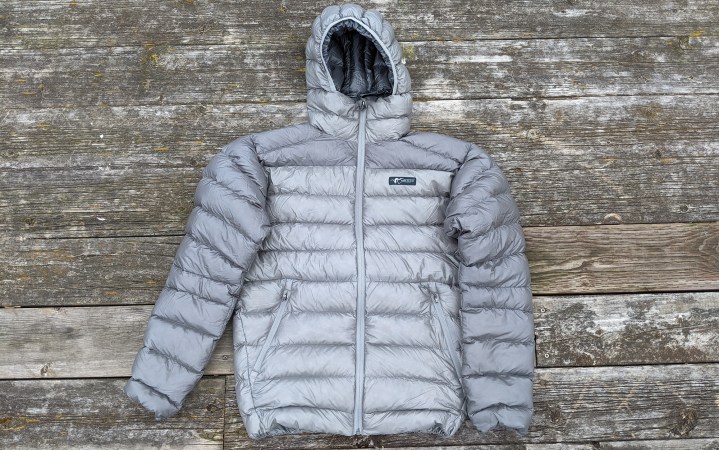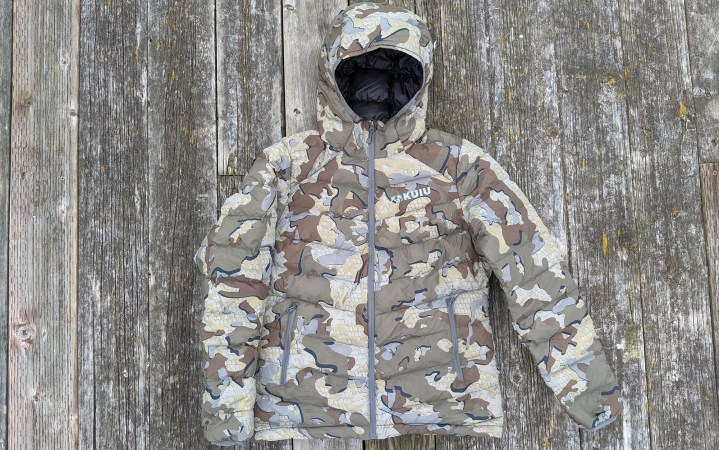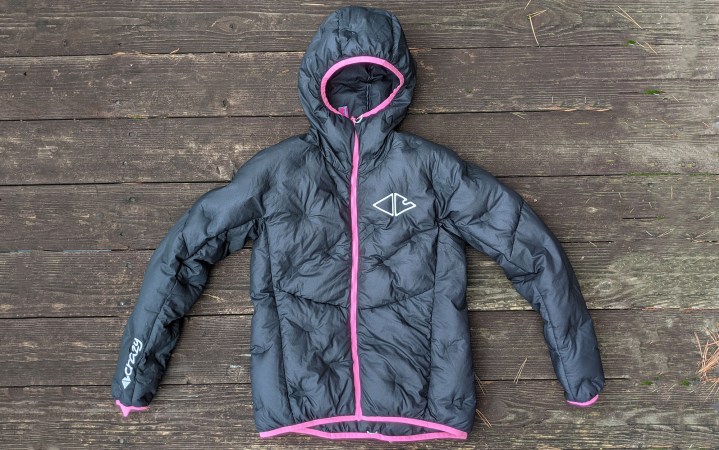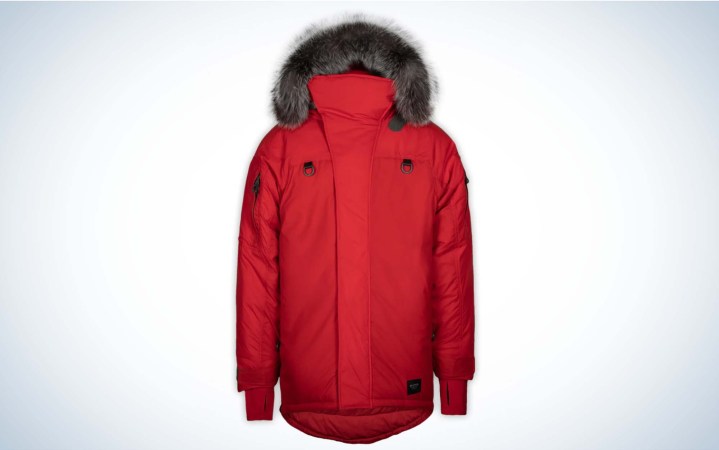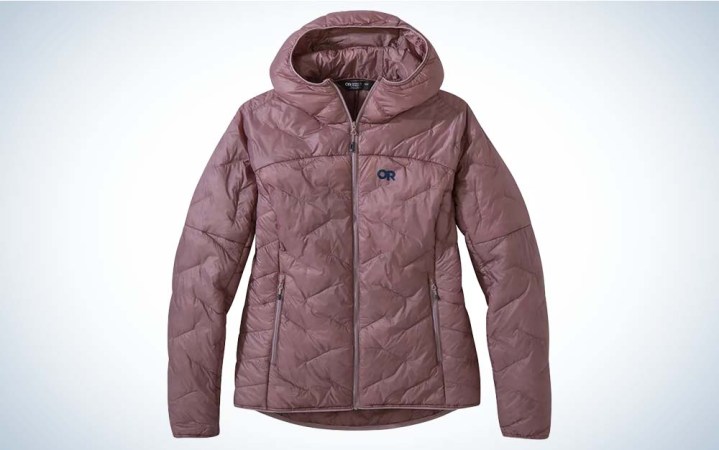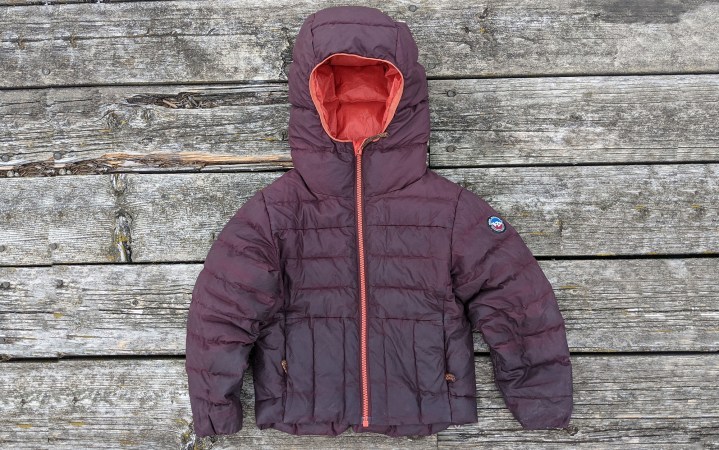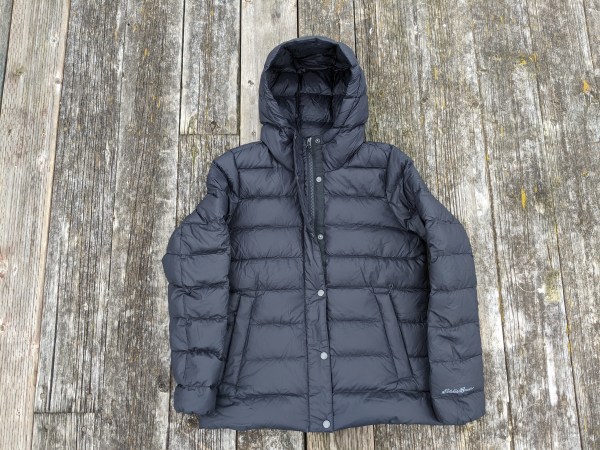We may earn revenue from the products available on this page and participate in affiliate programs. Learn More ›
The puffer jacket is the big guns of any backcountry layering system: its first and last job is to keep you warm in whatever conditions you expect to encounter. Now, granted, there are a lot of different types of conditions you can encounter in the outdoors, from sunrise summits to all-day deer hunts to sitting around the fire at camp. To help you choose the best puffer jacket for your next adventure, I’ve narrowed it down the best eight:
- Best Overall: Big Agnes Women’s Luna Jacket/Men’s Shovelhead Jacket
- Best Upgrade: Stone Glacier Grumman Goose Down Jacket
- Best Lightweight: Kuiu SuperDown LT Hooded Jacket
- Best Ultralight: Crazy Levity
- Best for Extreme Cold: Beyond Clothing Allta Polar L8 Parka
- Best Synthetic: Outdoor Research SuperStrand LT Hoodie
- Best for Kids: Big Agnes Kids’ Ice House Hoodie
- Best Budget: Eddie Bauer Stratustherm Down Jacket
How I Tested the Best Puffer Jackets
I have been layering up in the outdoors for over a decade on everything from day hikes to thru-hikes. In that time, I’ve challenged puffer jackets to keep me warm in conditions ranging from single digits with wind chill to the dreaded 33 degrees and drizzling.
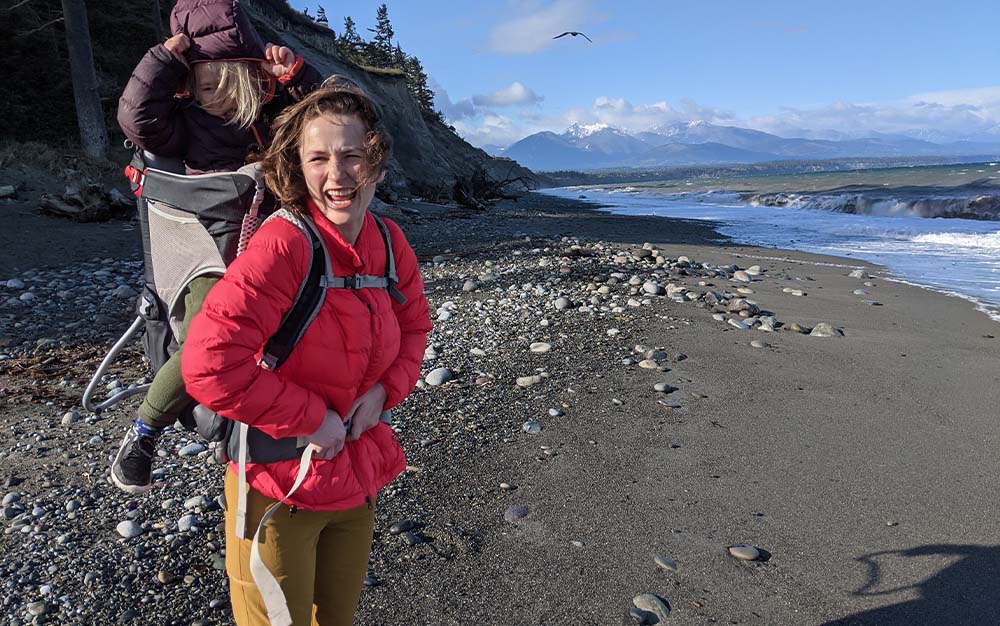
Many of the puffer jackets in this test were part of my test of the best down jackets. Others were tested as standalone options in a wide range of environments, from casual camp days and spring turkey hunts to early-morning summit hikes and trail runs. Conditions ranged from bluebird skies with freezing temps to blasting rain with wind to heavy drizzle with humidity. Puffers were stuffed into daypacks, turkey vests, and even the pocket of my raincoat on one occasion. Where possible I brought multiple puffers with me, to compare how they performed against one another in similar environments. In addition to performance, I also compared fit, sizing, coverage, and features when making my best pick selections. My best for extreme cold pick comes from Tyler’s Freel’s test of the best jackets for extreme cold.
Best Puffer Jackets: Reviews & Recommendations
Best Overall: Big Agnes Women’s Luna Jacket/Men’s Shovelhead
Key Features
- Sizes: Men’s and women’s XS-XXL
- Weight: 16 ounces (men’s); 15 ounces (women’s)
- Fill: 700fp down
- Pockets: Two zip pockets at waist; stuff pocket at inside right side
- Hooded only
Pros
- Extremely warm
- Thumbholes at the end of the sleeves
- Generous hood and collar
Cons
- Heavier than other puffer jackets in my test
Where some puffer jackets cut back on down to save weight or to create a more flattering silhouette, the Big Agnes Shovelhead and Luna goes in the opposite direction: it packs it in. In fact, this puffer is packed with so much down that the first few times I wore it wisps would poke out of the shell—something that usually only happens with sleeping bags (don’t worry, this stopped happening pretty quickly). So even though the Shovelhead/Luna isn’t using the fanciest fill power on the market (700fp), it’s using so much of it that similarly priced puffer jackets just can’t keep up.
With the Luna (the women’s version of this coat), I was never cold during testing, much of which took place during an unusually wet and cold spring in the Pacific Northwest. But there are a few other reasons I keep grabbing for this puffer jacket. The first is a generous hood that would be easy to layer a hat or helmet underneath and a high collar that I could pull up to my nose. It’s worth noting that this extra protection did not obscure my vision at all. It also had thumb holes at the cuffs — something I appreciated while making coffee at dawn on a particularly cold spring day.
While the Shovelhead and Luna puffer jackets pack down reasonably well, they are significantly heavier than other picks on this list. They weigh about twice the weight of my best lightweight pick. If you’re looking for an ultralight puffer for your next backpacking trip, this might not be the right pick for you, but for serious warmth in the winter and shoulder seasons, this one is tough to beat.
Best Upgrade: Stone Glacier Grumman Goose Down Jacket
Key Features
- Sizes: Men’s S to 3X
- Weight: 11.8 ounces (men’s S)
- Fill: 850fp down
- Pockets: Two zip pockets at waist
- Vest option available (as well as pants!)
Pros
- Very warm and comfortable
- Surprisingly durable
- Excellent weather resistance
Cons
- No women’s option available
- Heavier than other options I looked at
The Stone Glacier Grumman Goose Down Jacket checks all the boxes. Along with the Big Agnes Luna and Fjallraven Expedition Pack, it’s one of the warmest jackets I’ve tested, while still being several ounces lighter that similarly bulky options. It also does an excellent job at keeping cold air from sneaking through the sides, with a light elastic around the cuffs that is comfortable and secure and an extra elastic section inside the hood that provides additional security. It was surprisingly water resistant, with no loss of loft detected when I submerged the cuff in water, and no water penetration detected when I left a quarter cup of water on the back of the jacket for two hours.
The 15D Pertex Quantum shell was exceptionally smooth and comfortable, but I was concerned that the thinness of the fabric wouldn’t stand up to the durability test. I was wrong. In the first test, involving shoving my arm into a thicket of blackberry brambles, it came out with just a few scrapes and no visible holes. The second test had me stacking increasingly heavy weights on the jacket and then dragging it across rough asphalt. At 10 pounds, the maximum in my test, the Stone Glacier Grumman Goose Down Jacket, was massively scraped up, but had no holes and no down escaping.
If you’ve been looking for a down jacket that can handle serious backcountry conditions, this one is a no-brainer. They also offer a version with a couple ounces less down if you’re looking for a more lightweight option for milder conditions.
Best Lightweight: Kuiu Super Down LT Hooded Jacket
Key Features
- Sizes: Men’s S to 3X, women’s XS to XL
- Weight: 7.5 ounces (women’s S tested); 7 ounces (manufacturer provided)
- Fill: 850fp down
- Pockets: Two zip pockets at waist
- Hooded, non-hooded, and pants options available
Pros
- Great warmth for weight
- Good durability and water resistance
Cons
- Strange crinkly sound
- The outer edge of the cuff holds onto water, which can be uncomfortable
I wasn’t expecting to find a better puffer jacket option for the lightweight backpacker and backpack hunter set than the Mountain Hardwear Ghost Whisperer, but the Kuiu SuperDown LT Hooded Jacket edged it out in several categories. While these jackets are similarly warm with similar water resistance, the Kuiu is less expensive and a touch lighter weight (think a few tenths of an ounce). More importantly: It is noticeably more durable.
Oddly for a hunting brand, the Kuiu SuperDown LT is the only puffer jacket I’ve tested that produces audible noise. I’m not talking rain-jacket level of crinkle, but this isn’t a totally silent jacket.
Best Ultralight: Crazy Levity
Key Features
- Sizes: Men’s S to XL, women’s XS to L
- Weight: 6.1 ounces (women’s S tested), 5.4 ounces (manufacturer provided)
- Fill: 950 fp down
- Pockets: Zip pocket at inside right waist
- Hooded option only
Pros
- Lightest down jacket I looked at
- Good warranty
- Surprisingly warm
Cons
- Very expensive
- Not as durable as other picks on this list
- Few features like pockets or hem drawstrings, etc.
The warmth to weight of the Crazy Levity is off the charts. It weighs over an ounce less than its closest competitor (the Mountain Hardwear Ghost Whisperer 2) and was just as warm, if not warmer, than that jacket.
There are a couple of ways the Crazy Levity pulls off this impressive feat. The first is to simply use the highest grade down it can: 950 fill power to 1000 fill power. And it doesn’t skimp on it either. A full 2.4 ounces of the total 6.1 ounces of the jacket are down. Next is a unique approach to baffling. Rather than sew in traditional baffles, they have small ovals glued in at periodic intervals that helps to keep the down separated and evenly distributed. I’ve been wearing this jacket on a regular basis for months and have not noticed any cold spots as a result of unevenly distributed down, so I’d say it’s plenty effective.
The Crazy Levity also dispenses with anything resembling an extra. There is only one zip pocket on the jacket (inside at the right waist) and there are no drawcords or adjustment points to cinch the hem or the hood, just a touch of elastic to hold it in place. During testing, however, this felt like enough. I couldn’t feel the cold creeping in anywhere. The fabric is also not especially water repellent (despite being treated with DWR) and absorbed essentially all of the water during my test of water resistance (the jacket still lofted fine, however). Keep in mind that, as an ultralight puffer jacket, this has a wafer-thin 7D shell. Don’t take this one bushwhacking, but if it accidentally scrapes up against some Devil’s Club, it’ll probably be fine.
The real downside to the Crazy Levity is its price, which is hundreds of dollars more than anything else I looked at. That is somewhat ameliorated by the warranty, which is second only to Patagonia’s and Forloh’s. This one is a Satisfaction Guaranteed warranty, which means that, unlike limited lifetime warranties, there isn’t an arbitrary age of the garment at which point the warranty stops being in play. However, they do not cover improper care of the garment, including improper washing or drying, exposure to the sun, or contact with external agents, like scraping against rocks, snagging on your backpack, or in my case, being dragged along the pavement. Still, it’s a surprisingly good warranty given how delicate this down jacket is.
Most people will look at the Crazy Levity and decide (rightly) that it’s not for them. But if you’d pay almost anything to scrap a couple of ounces from your pack weight and are willing to baby your gear, it’s a must have.
Read the full review: Crazy Levity: Can a Super Ultralight Puffer Actuall
Best for Extreme Cold: Beyond Clothing Allta Polar L8 Parka
Key Features
- Sizes: S-XXL
- Weight: 3.7 pounds
- Fill: 8-ounce PrimaLoft Gold Eco
- Pockets: Four external cargo pockets, two large elastic hammock pockets inside coat
- Hooded option only
Pros
- Lightweight and warm
- Shell material maintains mobility in extreme cold
- Excellent wind blockage
- Quick-drying
- Real fur ruff
Cons
- Shell not ideal for rough use
Across the wide variety of jackets that I tested, the Allta Polar L8 was far and away the best jacket for brutally cold weather. It’s similar in some ways to the old canvas fur-ruffed parka that my dad used when working in Prudhoe Bay in the late 1970s, and the old, discontinued Cabela’s parkas, except that this is a lighter, warmer, and more responsibly sourced coat.
It features a lightweight nylon ripstop shell that’s DWR treated and water resistant. When the mercury plummets to minus 20 degrees, many jacket shells become stiff, loud, and inhibit your movement. That’s not the case here. The coat feels light, and movement is easy.
The PrimaLoft Gold insulation packs down well, but offers exceptional warmth, while drying faster than down. One of the fastest ways to freeze in extreme cold is to sweat out and soak your parka. This PrimaLoft dries quickly, even with only your body heat. This coat also stops the wind exceptionally well: When standing upright riding at temperatures around minus 25 degrees, I never felt any cold spots. Extreme cold demands that you use a lot of gear, and I really appreciate the hammock-style elastic pockets inside the coat flaps. They’re perfect for extra gloves, hats, or face masks.
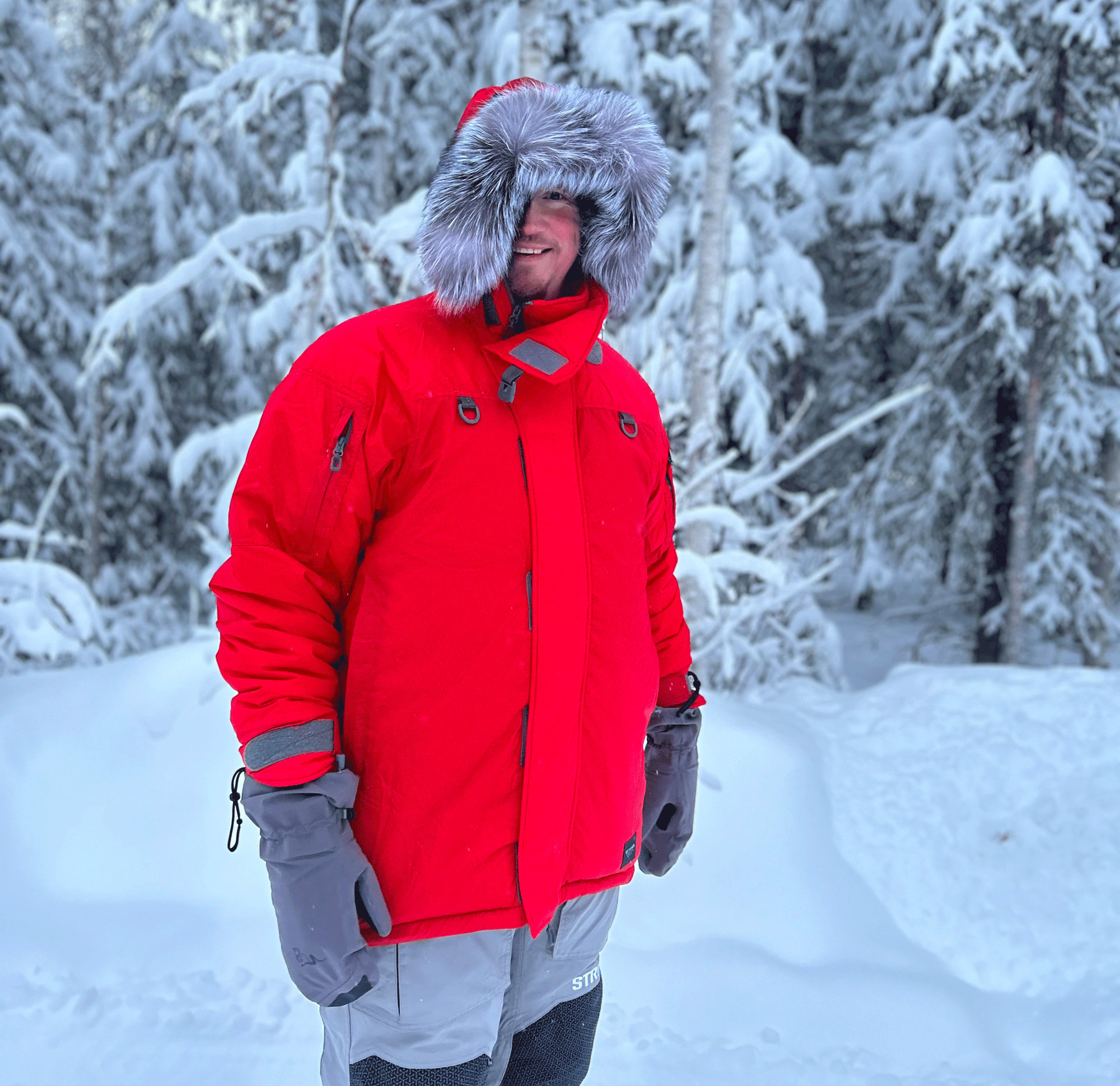
Tyler Freel
Many cold-weather coats are weak in the hood and collar, and sometimes the collars are entirely too tight to zip or fasten completely. The Allta Polar L8 has an excellent insulated hood and collar. The collar has plenty of material to zip up over a mask or neck gaiter, and it has an enlarged weather flap that has both hook-and-loop and a snap-in fitting to secure it over your face. The hood features a zipper-removable Finnish fox fur ruff that, unlike most fashion-inspired ruffs, serves its purpose well. The fur ruff’s purpose when fully extended with the hood up is to maintain a warm pocket of air on your face. This is centuries-old technology, and it works. With the hood secured and the ruff extended forward, I could ride without goggles at minus 25 degrees comfortably. Without a ruff or goggles, the biting cold air feels like someone’s driving a nail between your eyes. I appreciate Beyond’s use of these Finnish-farmed silver fox fur ruffs; my only critique being that fox is a very fine-haired fur, and not very durable. I’d rather see a coyote ruff used, and I’ll likely see about replacing mine with a nice wolf or wolverine ruff.—Tyler Freel
Best Synthetic: Outdoor Research SuperStrand LT Hoodie
Key Features
- Sizes: men’s S-XXXL; women’s XS-XL
- Weight: 10.9 ounces (men’s); 9.6 ounces (women’s)
- Fill: polyester
- Pockets: Two zip pockets at the waist
- Hooded, non-hooded, and vest options available
Pros
- Better water resistance than traditional down puffer jackets
- Durable
- Roomy fit allows for plenty of layering underneath
Cons
- Not as warm as other puffers in my test
Horizontal baffling has long been the hallmark of the best puffer jackets, as without these compartments, the down fill would bunch together at the bottom—not very effective if you want to keep your upper body warm. But baffling can also limit the warmth provided by puffer jackets, as each of those seams represent a spot where cold air can more easily seap inside the coat.
The synthetic fill here is a little different. Instead of innumerable wisps forming pockets to trap warm air, the VerticalX SuperStrand insulation is made up of long strands of polyester with pockets along the entire length. There are a few advantages to this. First, you can dispense with much of the baffling, as the longer strands will hold in place better than the small down feathers or their synthetic counterparts. That means fewer cold spots on the coat and fewer fail points in the stitching itself. Also, because there are fewer strands needed in this type of construction, the down is less likely to clump together with continued use.
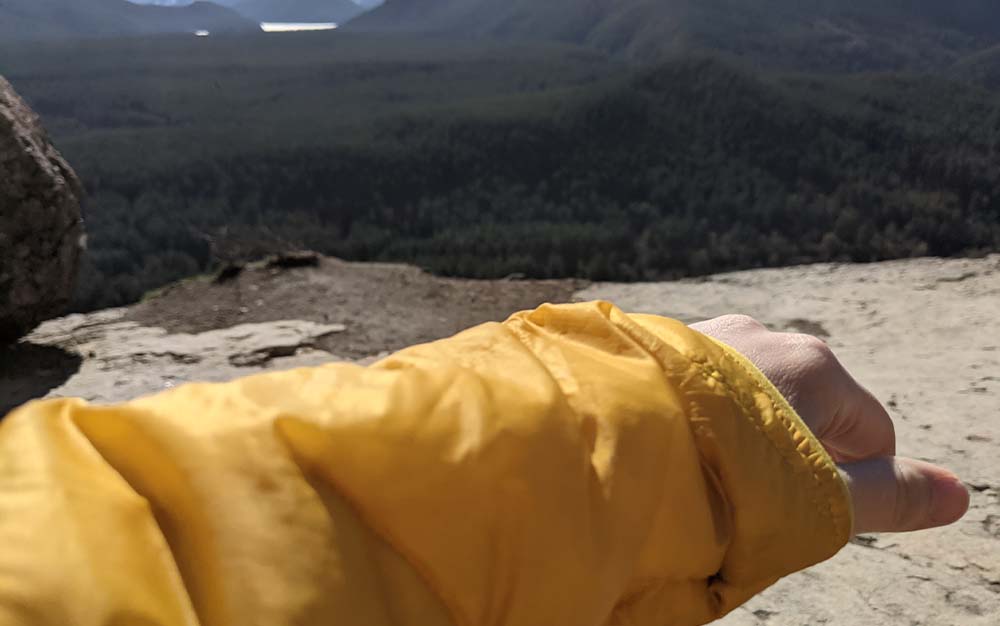
In my experience, the OR SuperStrand puffer jacket didn’t live up to its claim of matching the warmth to weight ratio of a 700fp down coat, although its performance seemed to vary depending on conditions. On an early spring hike up 2,000 feet with bluebird skies, it kept me warm without overheating, and when I stopped to eat lunch on an excessively breezy ridge I was just warm enough to not need a layer underneath. On the flip side, I was surprisingly cold wearing this coat on a damp camping trip on the Olympic Coast. This was the general theme during my testing. During active pursuits, this puffer jacket kept me warm down to surprisingly cold temperatures, but when I was stationary the chill crept in faster than I expected.
This one runs large, so size down if you are inbetween sizes.
Best for Kids: Big Agnes Kids’ Ice House Hoodie
Key Features
- Sizes: XXS-XL
- Weight: 12 ounces
- Fill: 600fp down
- Pockets: Two zip pockets at the waist
- Hooded option only
Pros
- One of the warmest puffer jackets for kids available
- Extremely durable
- Smallest size fits older toddlers
Cons
- No matching Ice House puffer pants (please?)
Finding high-quality outdoor clothing for kids can be challenging, as plenty of pint-sized apparel is built with the idea that you’re going to take a break from your outdoor pursuits now that you’re a parent. But you aren’t, are you? Yeah, me either. So the gear we get for our kids needs to be able to keep up with the gear we already have for ourselves.

That’s what the Big Agnes Ice House is. I’d say it’s like the mini version of my best overall pick—the Shovelhead/Luna puffer jacket—since it shares some basic design similarities, including the generous hood and collar, drop-tail hem, and lots and lots of puff (600fp vs the 700fp of the adult version). But honestly the Ice House might be even better. In the six months my two-year-old has been wearing this coat, it’s been through the wringer: snow, rain, wind, mud, sand, juice spills, pasta dinners. I’ve never washed it. It still looks great. But perhaps most importantly, she likes going outside when she’s wearing it, and she likes wearing it when she’s outside. Now if only I could get her some puffer pants that were of similar quality.
Best Budget: Eddie Bauer Stratustherm Down Jacket
Key Features
- Sizes: Men’s S to XXL, women’s XS to XXL
- Weight: 10.8 ounces (women’s S, tested); 11.8 ounces (manufacturer provided)
- Down Volume: 35 liters of loft potential (3.5 ounces at 650 fill power)
- Pockets: Two zip pockets at waist
- Hooded, non-hooded, vest, and parka versions available
Pros
- Affordable
- Warmer than I was expecting
- Very durable
Cons
- Snap buttons are unnecessary and annoying to use
- Worst warranty in my test
- Fit wasn’t as good as some of the more expensive down jackets
I’ve tried my fair share of budget down jackets in the past, including the Decathlon Forclaz MT100 and the Uniqlo Ultra Light Down Parka. If you’re working up a sweat on a day hike, these are probably fine. If you’re waking up in the alpine to close to freezing conditions? Absolutely not. They just aren’t warm enough.
While the Eddie Bauer Straustherm Down Jacket isn’t the warmest jacket I’ve looked at, it got the job done in all categories. It’s warm enough, plenty water resistant, and was one of the most durable jackets I tested, with only a few scrapes on the back after being dragged across a parking lot with a 10-pound weight on its back.
Which is good, because this was the only jacket in my test that had only a one-year warranty on it. The other downside to this jacket is that the fit isn’t great. It’s not especially form fitting, and the hood (which is an important part of how this jacket was keeping warmth in) was a looser fit than others that I looked at. There also wasn’t any way to cinch the hem, which is a useful way to keep out cold gusts on windy days.
Read Next: The Best Base Layers of 2023
Things to Consider Before Buying a Puffer Jacket
Insulation
The two main types of insulation are down (sourced from geese, or less commonly, ducks) and synthetic. Each has their own pros and cons.
Down is easily the best insulator out of any of these and provides more warmth for weight than just about any other material used in outdoor gear. If you look at a down feather, you’ll see that it’s made up of innumerable wisps connected to a short shaft. The lack of structure to these feathers creates small air pockets, which trap heat from your body and insulate it from the cold outside air. Down-feather quality is measured by fill power (fp), or how much down it takes to fill one cubic inch of space. For instance, one ounce of 550fp down will fill about nine liters, while one ounce of 900fp will fill almost 15 liters.
The Achilles heel of down feathers has always been moisture. When down gets wet, the pockets of air disappear, eliminating virtually all of its insulating properties. In recent years, manufacturers have started using down feathers treated with a water-resistant coating, sometimes referred to as DownTek, but there are several different names. While the water-resistant coating provides some protection, a soaking-wet down coat will not provide anywhere near the same insulation as a dry one. With down products, it’s also worth checking whether the product is RDS (Responsible Down Standard) certified, which helps ensure that no geese or ducks were unnecessarily harmed (such as live plucking).
The sleeping bags of slumber parties are a good example of synthetic fill. High-end synthetic fill mimics the qualities of down by using short filaments to create pockets that trap body heat. Further, synthetic fill retains heat while wet without the need for additional treatment. The highest quality synthetic fills can approach the insulation-to-weight ratio of 550fp down, but these synthetics also approach the cost of lower quality down.
Shell Material
Down and synthetics are typically encased by nylon of varying thicknesses, which is measured in denier (D). Most puffer jackets use fabrics between 10D and 30D (although our best ultralight pick pushes the envelope by taking it down to 7D). Polyester, which isn’t as strong as nylon, is sometimes used on the lining of puffer jackets.
FAQs
Essentially, the warmest, best puffer jacket is the one with the most insulation. That insulation could be synthetic fill — and a lot of it — or high-loft down. A jacket with 900-fill down or higher will be one of the loftiest options out there. But also take note of the amount of insulation; Even a super-high fill power won’t deliver maximum warmth unless there’s a lot of the down stuffed in the jacket.
Short answer: No. Puffer jackets should not be tight. Puffy jackets are warm because the insulation inside of them traps warm air against your body. If your jacket is too tight, you might compress some of those air pockets, compromising the warmth. Puffer jackets also work well as part of a layering system that includes a base layer and sometimes a midlayer underneath them for versatility. So, you’ll often want a puffer jacket that has a cut that’s relaxed enough to fit over multiple layers. But that doesn’t mean you want a baggy fit, either: Aim for a comfortable cut that will also fit under a waterproof shell if necessary.
You should wear a puffer jacket in cold weather — but not always. If you’re doing something very active, such as cross-country skiing or trail running, even in very cold weather, a puffer jacket will likely be too warm. But if you’re hiking at a moderate pace, sitting in a treestand, or relaxing at camp, a puffer jacket will make you comfortably toasty. It’s a great idea to pull a puffy coat out of your pack to wear during breaks in cold-weather activities, too. It’s much easier to stay warm than to get warm.
Down puffer jackets are perennially popular for their warmth-to-weight ratio, breathability, durability, and packability. If weight and packed size are a concern because you’ll be carrying the jacket in your backpack on skiing, hiking, or hunting trips, a down jacket might be best for you.
Final Thoughts
Despite the impressive inroads of synthetic fills over the last decade, down fill is still the warmest insulation you can find for the best puffer jackets. While the Big Agnes Steelhead/Luna jacket is one of the best values for warmth currently available (and the pint-sized Icehouse is an excellent choice for keeping tots outdoors year round), the Kuiu Super Down and Crazy Levity both impressed me for their weight-to-warmth ratio.
